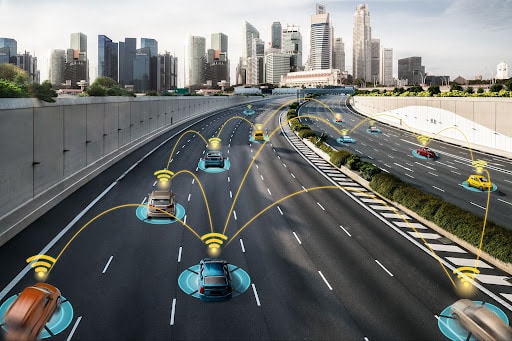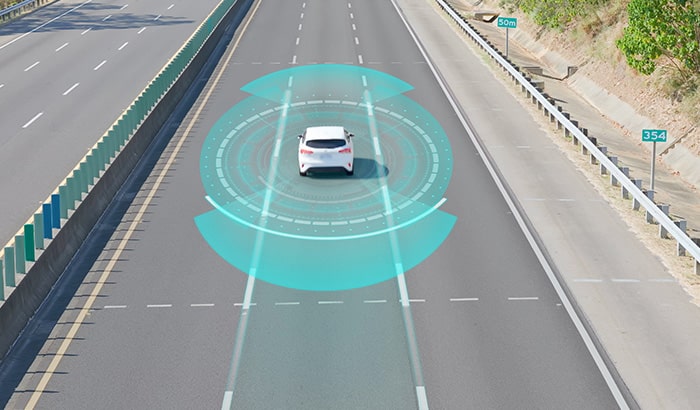Advanced Driver Assistance Systems (ADAS) are quickly becoming an irreplaceable part of road safety. Imagine navigating a congested highway, and your gaze drifts to a billboard. In that brief moment, the Advanced Driver Assistance Systems in your vehicle become your unseen hero.
As the car ahead abruptly stops, ADAS reacts instantly to avoid a crash. This scenario is not a futuristic fantasy; it’s the current reality, with ADAS reshaping our driving experiences by enhancing road safety.
Advanced Driver Assistance Systems have become a cornerstone of modern automotive safety in our ever-evolving world of technology. These systems combine various sensors and technologies to aid drivers, significantly reducing the likelihood of accidents and enhancing overall road safety.
In this article, we will dive into ADAS’s importance, its components, benefits, and pivotal role in the journey toward fully autonomous vehicles.
The Rise of ADAS: A Brief History
The concept of assisting drivers with technology isn’t new. It’s been around for decades, and innovations such as Anti-lock Braking Systems (ABS) and Electronic Stability Control (ESC) have been stepping stones to the sophisticated systems we see today. ADAS has grown from simple beeping parking sensors to complex networks of devices working in concert to navigate the intricate ballet of modern traffic.
Understanding ADAS: Components and How They Work
At the heart of ADAS are sensors—cameras, radar, ultrasonic, and LIDAR—that serve as the eyes and ears of the system.
These sensors constantly gather data, which sophisticated software interprets, leading to actionable inputs that might involve adjusting your vehicle’s speed, steering, or braking to ensure safety. This interaction represents the seamless fusion of mechanics and digital intelligence that defines ADAS.
Key Features of ADAS
Automatic Emergency Braking (AEB)
Automatic Emergency Braking is a safety feature that detects an impending collision and automatically applies the brakes to avoid the accident or lessen its impact. AEB systems use sensors such as radar, cameras, and LIDAR to monitor the vehicle’s surroundings. The Insurance Institute for Highway Safety (IIHS) has stated that AEB reduces rear-end crashes by about 40%.
Blind Spot Detection (BSD)
Blind Spot Detection systems alert drivers when a vehicle enters their blind spot while driving. This feature typically uses radar or cameras to monitor areas around the vehicle that are difficult for the driver to see.
When a vehicle enters the blind spot, an indicator light will appear in the corresponding side mirror. If the driver signals a lane change while a vehicle is in the blind spot, an audible, visual, or haptic signal will warn the driver.
Cross Traffic Alerts
Cross Traffic Alert systems are particularly useful when reversing out of parking spaces. These systems detect vehicles approaching from either side and alert the driver with audible and visual warnings. They can save lives in busy parking lots where larger vehicles or obstacles limit visibility.
Parking Assistance Systems
Parking Assistance systems have evolved from simple distance alerts to advanced systems capable of steering a car into a parking space while the driver controls the throttle and brakes. These systems take the stress out of parking in tight spaces by calculating the steering angle and guiding the vehicle into place.
The Importance of ADAS
Statistics on ADAS and accident prevention
According to the National Highway Traffic Safety Administration (NHTSA), ADAS features have the potential to prevent over 2.7 million crashes, 1.1 million injuries, and nearly 10,000 deaths each year. Lane departure warnings alone can reduce single-vehicle, sideswipe, and head-on collisions by 11%, and when combined with Lane Keeping Assist, the reduction can be as much as 21%.
ADAS as a stepping stone to autonomous driving
Advanced Driver Assistance Systems are about more than merely enhancing safety in our present driving environment; they are laying important groundwork for the future of autonomous driving.
These systems are pivotal in the evolution toward fully self-driving vehicles. ADAS equips cars with the ability to perceive and intelligently react to the dynamic world around them.
This involves refining sensor accuracy, decision-making algorithms, and ensuring seamless integration with vehicular control systems. This development is a stepping stone in an ongoing journey towards vehicles that navigate the complexities of road travel independently, promising a future where safety and efficiency are significantly enhanced.

Human Factors: How ADAS Changes the Way We Drive?
The interaction between human drivers and ADAS
The delicate coexistence between human drivers and ADAS demands that the driver stay engaged and aware while these systems assist. Misusing or overrelying on ADAS might lead to complacency, which is why continuous driver education on these systems is essential.
Reliance on technology vs. driving skills
There is a concern that, as drivers become more accustomed to ADAS, their driving skills may deteriorate. Driver training programs must adapt and reinforce the importance of maintaining driving skills even as technology takes on more driving tasks.
The importance of driver education on ADAS use
Educating drivers on what ADAS can and cannot do is paramount to its success. This includes understanding the technology, knowing how to activate and deactivate systems, and knowing the systems’ operational boundaries.
The Future of ADAS
Advanced Driver Assistance Systems represent a quantum leap forward in automotive safety and technology. With every car that rolls off the assembly line equipped with these sophisticated systems, the fabric of vehicular travel is rewoven into a tapestry that prioritizes human life, efficiency, and environmental consciousness. The impressive statistics showcasing reductions in accidents and injuries attest to the efficacy of ADAS.
As we move forward, it is imperative to maintain a balance between leveraging technology for safety and preserving the critical skills of human drivers. ADAS serves as a copilot, not a replacement, for attentive driving. Emphasizing education about using ADAS will ensure drivers fully benefit from these systems while remaining alert and prepared to take control when necessary.
The road to fully autonomous vehicles is long and winding, with ADAS being the crucial mile marker guiding the way. These systems are not merely about correcting human error; they embody a proactive approach to preventing it.
They signal a future in which road fatalities and injuries may turn into rarities, where drivers experience reduced stress navigating complex traffic, and driving evolves into a collaborative effort between human intuition and precision engineering.
As we embrace ADAS, we must also assume the responsibility that comes with it. It requires manufacturers to improve the systems continuously, legislators to create informed regulations, insurers to recognize the value of ADAS, and drivers to update their driving practices.
The potential for creating safer roads is immense, and as we journey towards that horizon, ADAS will be the compass that ensures we are traveling and traveling well.
Understanding the full depth of ADAS is about appreciating the features of modern vehicles and recognizing critical components of our collective safety.
The importance of ADAS is beyond overstating – it represents an investment in a future where technology and humanity merge to forge a safer, more efficient driving experience. As this technology advances, our understanding and appreciation for the complex interplay among drivers, vehicles, and the journey ahead will also grow.
Need an ADAS Windshield Installed? Utah Mobile Auto Glass Can Help
Windshield cracks can occur at any moment, risking the proper function of your vehicle’s Advanced Driver Assistance Systems. Replacing a cracked windshield quickly is essential to maintain visibility and prevent accidents. Post-replacement, ADAS recalibration is a critical step.
Utah Mobile Auto Glass is proud of the strong reputation we’ve established. Operating from Sandy, Utah, we deliver outstanding ADAS windshield services across Salt Lake and Utah counties, including the Bountiful area.
Opting for our services guarantees top-notch customer care and total clarity from start to finish. Contact Utah Mobile Auto Glass today, and we’ll ensure you’re safely back on the road in no time.
toto slot







